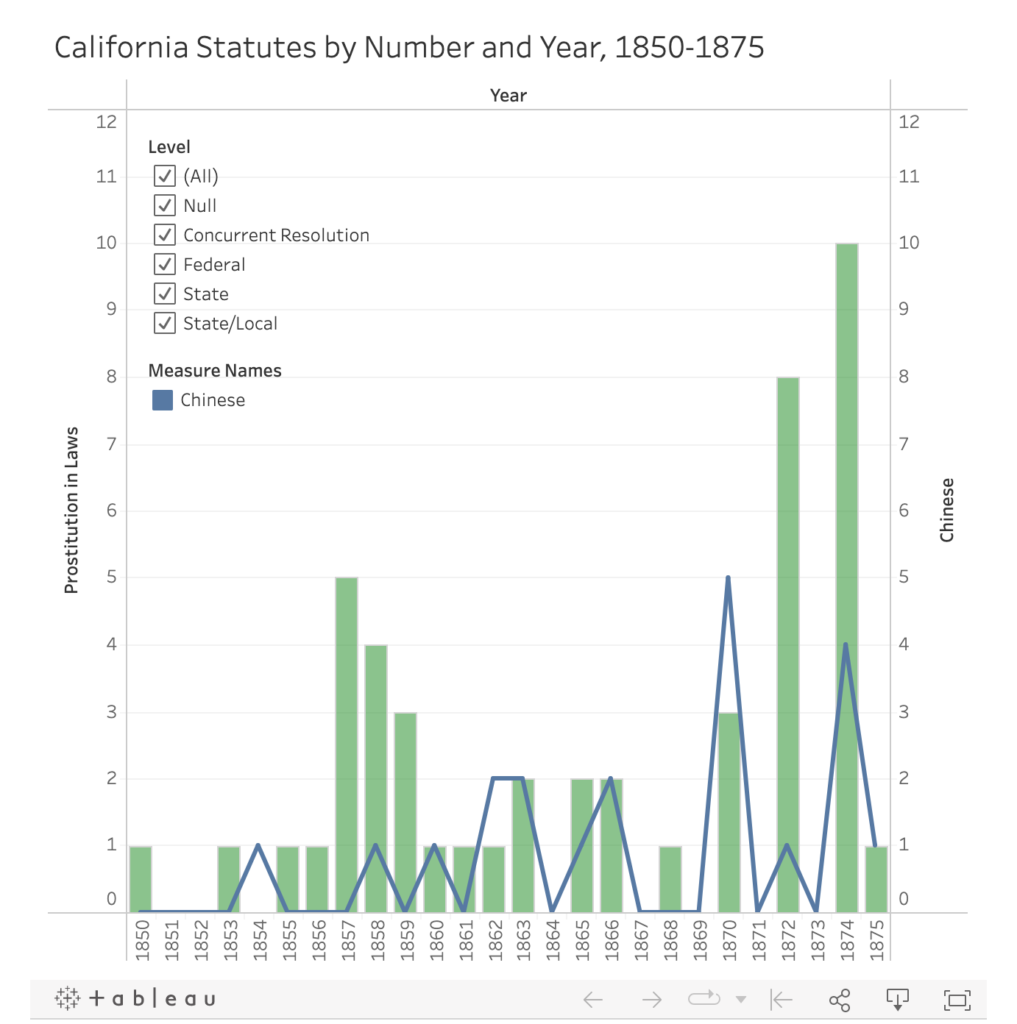For our independent study in digital history, I compared the amount of California state statutes concerning prostitution from 1850-1875 to the amount of articles printed in the Daily Alta California that mentioned the term “prostitute.” I wanted to see if there was any correlation between the amount of laws passed concerning prostitution and the amount of articles published that mentioned “prostitute(s)”.
Did greater public concern over prostitution in the Daily Alta California translate to greater laws? Did greater numbers of legislation pass result in more public awareness and concern over prostitution? Which prostitutes did legislation target? Which prostitutes did the Daily Alta California target in the press?
To answer such questions, data from the State Statutes of California was gathered into an excel sheet that tracked the year, level, and type of each law passed concerning prostitution from 1850-1875. Similarly, data from the Daily Alta California was gathered from the University of California, Riverside, and its database, the California Newspaper Digital Newspaper Collection, from 1850-1875. I tracked the month and year each article was published, as well as what type of article it was, and the major topics of each article. To see my comparisons between the two see the link below for the final graph: https://public.tableau.com/views/IndependentStudyCaliforniaStateLawsinRelationtooneSanFranciscoNewspapersReport/ProstitutionLawsComparedtoOccurrencesintheDailyAltaCalifornia1850-1875?:language=en-US&publish=yes&:display_count=n&:origin=viz_share_link
Because of the 1875 Page Act, which outlawed Chinese “coolie” labor and women of “lewd or immoral character,” for the purposes of prostitution, I thought there would be a large amount of articles published by the Daily Alta focusing on Chinese prostitution. As one of California’s oldest and longest-running publications, based out of San Francisco, it was the best choice to compare the passing of laws to public sentiment. However, what the Daily Alta showed was that articles containing the word “prostitute” mostly concerned police records that did not indicate race, nationality, or ethnicity. Of 130 articles found from 1850-1875, only twenty-one identified prostitutes as “Chinese;” ten articles identified prostitutes as either “French,” “German,” or “Polish;” four articles identified prostitutes as “Mexican.” Other times, articles would use “European” as an identifier for specific prostitutes referenced in the articles.

This comparison did not support my original hypothesis. Although more of the articles identified specific prostitutes as “Chinese” than they did as “European” or “Mexican”, only 16% of all articles identified prostitutes as “Chinese.” Most of the articles described issues of crime, morality, and prostitution in general. However, if I were to do this project differently and expand my search, I would search different terms such as “ill-fame,” “lewd,” “immoral,” or “social evil,” in order to elicit a greater number of articles concerning prostitution in California from 1850-1875. Many of the laws passed during these specific twenty-five years used such terminology to mean prostitution, and cross-referencing these terms with newspaper articles that also used them might provide different results.

What was most surprising in this project was how much the laws and newspaper articles concerning prostitution did not match up. For example, in 1858 thirteen articles about prostitution were published by the Daily Alta. Comparatively, only four laws concerning prostitution were passed by the California State Legislature in 1858. A similar example can be seen in 1866: sixteen articles were published by the Daily Alta concerning prostitution whereas only two laws were passed in the same year concerning the same. From this small sample of comparative data, it does not show that there was a direct correlation between the increase in laws concerning prostitution to an increase in articles written about prostitution. In order to expand my results, I would use two other major newspapers published in different regions of California. I would choose one farther north from San Francisco and in a mining region, and another farther south.